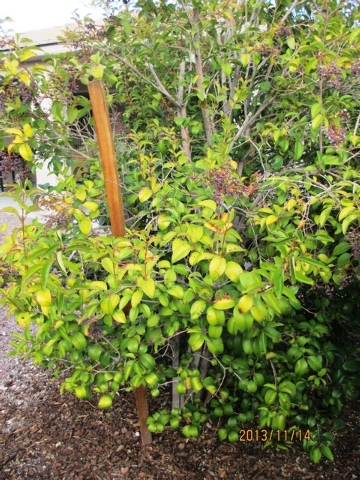Privets suffer from dieback when not watered frequently enough
Q: We have had these trees in our backyard for 15 years. I don’t know what they are. All of a sudden, one has a bare spot. What might this be? I enclosed a picture.
A: From your picture, the plant looks like Japanese or Texas privet. Privets are notorious for looking bad, leaf drop and twig dieback, when they are not watered frequently enough or not given enough water.
They usually do nicely in lawns or when surrounded by other plants with a similar water requirement.
Typically they do not perform well when planted by themselves in rock mulch or if the soil becomes excessively dry between irrigations. I would like to see the rock mulch replaced with wood mulch or other plants located around the base of the plant that require a similar watering frequency.
These extra plants provide some additional water to the soil and help keep it from drying too much.
Q: Every year about this time my grapevines become infested with gnats or some form of small flying bugs that swarm. Because I have my grapes trellised over a walkway, the gnats are a real nuisance when walking or sitting under the vines. What are these bugs, and how do I get rid of them?
A: It is a bit difficult to suggest a control without knowing which insect this might be.
Gnats are not a common problem on grapes this time of year or actually any time of year. Leafhoppers and whiteflies are, however.
Leafhoppers are small insects that “hop” from grape leaves but do not fly. They do hop off leaves in large numbers when you get close to the plants and can get in your face, nose and mouth. They are a nuisance, but flying does not fit their description.
We occasionally get whiteflies in grapes but as their name suggests they are “white.” They swarm, are small and also a nuisance. Gnats feed off decaying matter and small feeder roots of plants and do not normally feed on grape plants. They are more typically a problem during cooler times of the year or infesting houseplants.
Approaches to controlling leafhoppers and whiteflies are different from each other if, in fact, one of these is your problem. Leafhoppers leave tiny black specks on the leaves (their poop) and feeding damage makes the leaves have a bronzy appearance, speckled or appear off-color.
Whiteflies may also cause leaves to discolor but usually leave behind a sticky residue on leaves from their feeding. Since gnats don’t feed on plant leaves, they do not cause damage to the leaves but can be a nuisance.
Spinosad, applied in May and June, will usually reduce leafhopper numbers and help prevent their populations from escalating. Applied later than this has little control on adult insects.
Whiteflies are difficult to control but repeat applications of soap sprays, followed by Neem sprays, usually reduce whitefly numbers.
Q: Why are the leaves on my roses turning black?
A: There is quite a bit of shade on the leaves in the picture you sent. Is that typical? Too much shade could cause leaf drop.
One of your pictures has yellow leaves with green veins, typical of iron chlorosis, a lack of available iron. Otherwise these leaves look like they are dying back from the edges, a problem called leaf scorch.
Leaf scorch can be caused by a lack of water, salinity that is high levels of salts in the soil, rose cane borers that are disrupting the flow of water to the leaves, root dieback from root rot, disease such as collar rot, soil mineralization from a lack of organic matter in the soil and probably a few I didn’t think of.
Make sure these roses are getting adequate sunlight, soil amendments and wood mulch, watered appropriately and not excessively, fertilized appropriately including iron fertilizer once a year.
Roses have a life expectancy of about 10 years for most gardeners or a bit more if you care for your plants. Many homeowners hold on to roses much longer than they should and have difficulty replacing them when they should.
If these are in bad condition, replace them. Do not put roses in these locations if there is not at least six hours of full sunlight.
Bob Morris is a horticulture expert living in Las Vegas and professor emeritus for the University of Nevada. Visit his blog at xtremehorticulture.blogspot.com. Send questions to Extremehort@aol.com.

















